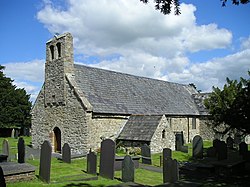Caerhun: Difference between revisions
Created page with '{{Infobox town |name=Caerhun |county=Caernarfonshire |picture= CaerhunChurchP9010457.JPG |picture caption=St Mary's, Caerhun |os grid ref=SH483601 |latitude=53.117 |longitude=…' |
No edit summary |
||
| Line 5: | Line 5: | ||
|picture caption=St Mary's, Caerhun | |picture caption=St Mary's, Caerhun | ||
|os grid ref=SH483601 | |os grid ref=SH483601 | ||
|latitude=53. | |latitude=53.217 | ||
|longitude=- | |longitude=-3.835 | ||
|LG district= | |post town=Conwy | ||
|constituency= | |postcode=LL32 | ||
|LG district=Conwy | |||
|constituency=Aberconwy | |||
}} | }} | ||
'''Caerhun''' is a village and parish on the west bank of the [[River Conwy]], to the south of [[Henryd]] and to the north of [[Dolgarrog]]. | '''Caerhun''' is a village and parish in [[Caernarfonshire]], on the west bank of the [[River Conwy]], which here forms the border with [[Denbighshire]]. It is situated to the south of [[Henryd]] and to the north of [[Dolgarrog]]. | ||
The parish population was 1,200 at the 2001 Census. | The parish population was 1,200 at the 2001 Census. | ||
Latest revision as of 10:41, 3 November 2023
| Caerhun | |
| Caernarfonshire | |
|---|---|
 St Mary's, Caerhun | |
| Location | |
| Grid reference: | SH483601 |
| Location: | 53°13’1"N, 3°50’6"W |
| Data | |
| Post town: | Conwy |
| Postcode: | LL32 |
| Local Government | |
| Council: | Conwy |
| Parliamentary constituency: |
Aberconwy |
Caerhun is a village and parish in Caernarfonshire, on the west bank of the River Conwy, which here forms the border with Denbighshire. It is situated to the south of Henryd and to the north of Dolgarrog.
The parish population was 1,200 at the 2001 Census.
The village

Surrounding the 14th-century parish church of St Mary are the banks of the Roman fort of Canovium. The excavations of the Roman site were directed by PK Baillie Reynolds, of Aberystwyth University, over a period of four summers in the 1920s,[1][2] although there have of course been several other publications since.[2]
The church and its churchyard occupy the north-east quarter of the original Roman site. Canovium was built at an ancient river crossing and was an important post on the Roman road and ancient drovers' road by way of Bwlch-y-Ddeufaen to Abergwyngregyn and the Menai Strait. Latterly the best crossing point, now with a bridge, has been at nearby Tal-y-Cafn.
After the Romans retreated from Britain, the fort was associated with King Rhun Hir of Gwynedd, hence the subsequent name.
References
- ↑ Baillie Reynolds, P.K. (February 1938). Excavations on the site of the Roman fort of Kanovium at Caerhun, Caernarvonshire: collected reports on the excavations of the years 1926-1929 and on the pottery and other objects found. Kanovium Excavation Committee. Cardiff: William Lewis, Printers. 282 pages. Baillie Reynolds' reports were originally published in Archaelogia
- ↑ 2.0 2.1 "Read a book Visit a Museum: Kanovium Project Book Reviews". http://www.betws31.freeserve.co.uk/Books_about_Caerhun_Fort/books_about_caerhun_fort.html. Retrieved 2009-10-28.. Page found on Kanovium Project website